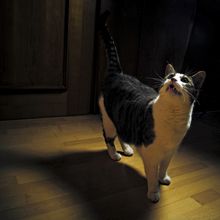Interpreting feline vocalization patterns
Learning to read the feline dictionary helps prevent injury, maintain human-animal bond.

Getty ImagesNonverbal communication is fascinating to most people, especially to animal lovers, says Jeanine Berger, DVM, DACAW, DACVB, who's with the San Francisco SPCA. Humans rely heavily on verbal communication, she told her veterinary audience at CVC Washington, D.C., in April but misunderstandings do happen. And if we're at times unsure about our own species' body language, how much more difficult is it to understand the body language of a different species-such as cats?
Berger offered veterinarians a “feline dictionary” for translating vocalization patterns. Compared to dogs, she said, cats are not as obviously vocal. However, certain cats are more vocal than others and cats can learn to use vocalization to communicate with people. Failure to read the “dictionary” correctly, she warned, can lead to human injury, a fracture in the human-animal bond and a decrease in animal welfare. Here's a sampling of Berger's feline vocalization dictionary.
Murmur. A soft, rhythmical pulse given on exhalation. Interpretation: Request or greeting.
Meow. Characteristic feline call-“mee-ah-oo.” Interpretation: An all-purpose greeting.
Purr. Soft, buzzing, rapid contractions of the muscle of the larynx. Interpretation: Sign of contentment; however, a cat may also purr when it's anxious or sick.
Growl, hiss and spit. Harsh, low-pitched, open-mouth sound; can be explosive. Interpretation: Cat is feeling defensive, frightened, stressed or aggressive. Leave this cat alone!
Squeak. High-pitched, raspy cry. Interpretation: Used in play or feeding; heard in females after copulation.
Shriek. Loud, harsh, high-pitched sound. Interpretation: Cat is feeling intensively aggressive or painful. Stop what you are doing; it is not working for the cat.
Chatter. Teeth chatter together. Interpretation: Cat is hunting or is being restrained from hunting.
Estrus call. Long-lasting, variable-pitch sound; cat starts with open mouth then gradually closes it. Interpretation: Female in estrus.
Howl and yowl. Loud, harsh, drawn-out calls. Interpretation: Cat is feeling aggressive or in distress. Elderly cats with cognitive disorder make this sound.
Mowl or caterwaul. Variable-pitch call. Interpretation: Male sexual call.
Mew. High-pitched, medium-amplitude, long “eee.” Interpretation: Mother interacting with kittens.
Moan. Low-frequency, long-duration “oo” or “uu.” Interpretation: Used in epimeletic situations or before a cat coughs up a hairball.
For more on this topic, see dvm360.com/felinedictionary.